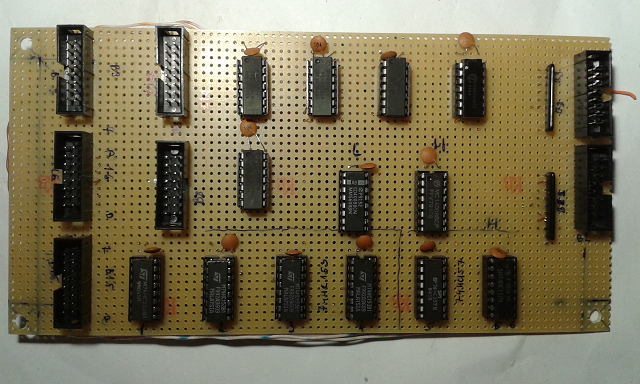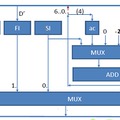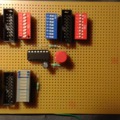The ALU module is very simple and straightforward. It is mounted together with the control board encoding logic on a single board. It performs a simple addition operation on the two operands as described in the following table. The two selector bits define the two input sources.
|
ALU selector |
Input A |
Input B |
Carry |
Result |
Usage |
|
00 |
0000 0000 (0) |
V |
0 |
V
|
Identity / copy |
|
01 |
AC
|
V’ |
0 |
AC+V’
|
Argument counting
Only four bit value is used |
|
10 |
1111 1110 (-2) |
V |
0 |
V-2 |
Used to set AC to 1 argument, provided that V is zero beforehand |
|
11 |
SI |
V’ |
0 |
SI+V’ |
Argument binding |
|
00 |
0000 0000 (0) |
V |
1 |
V+1 |
Increment |
|
01 |
AC |
V’ |
1 |
*AC+V’+1 |
|
|
10 |
1111 1110 (-2) |
V |
1 |
V-1 |
Decrement |
|
11 |
SI |
V’ |
1 |
*SI+V’+1 |
|
*these combinations are actually not used.
where V’ denotes 1111 11 V(1) V(0), where V(1) and V(0) are the two least significant bits of V.
Notice that the ALU is able to generate V (identity), V-1 (decrement), V+1 (increment) and V-2 based on the V value.
Please also observe that since this is a 7-bit CPU, it is not desirable to go out of the seven bit range. In other words, (without the tag interpretation) when V is holding a constant it cannot go beyond the range of 0..127 no matter if it is incremented or decremented. Therefore when storing the modified V value (here we mean solely V-1, V+1, but not V’) to the expression cell as defined by the destination register, the original most significant bit of the V register is fed back along with the possibly modified 7 bit part of the ALU result. This way the highest bit is always reserved and the actual constant part of the result value must lie in the 7 bit range.
Partially, in line with the aforementioned, the content of V register is not directly connected to the databus, instead, the ALU output (except for the MSB, which is coming from the V register) is released to the databus.

Input sources are mapped by six multiplexers. Four 74HC153s are utilized to select among four sources (SI, AC, 0, -2), and two 74HC157s are used to select between V and V'. The outputs of these multiplexers are fed to two 4008s to perform the 8 bit addition.
Bus 15 connects register and ALU modules transferring the following signals to the ALU:
| V7 | V6 | V5 | V4 | V3 | V2 | V1 | V0 |
| SI7 | SI6 | SI5 | SI4 | SI3 | SI2 | SI1 | SI1 |
Bus 16 supplies the full 8 bit ALU result to the register module. This value is used in the course of argument binding.
| R7 | R6 | R5 | R4 | R3 | R2 | R1 | R0 |
Bus 9 has similar content, with a different arragnement. It transfers signal from the ALU to the RAM module.
| R6 | R4 | R2 | R0 | ||||
| V7 | R5 | R3 | R1 |
Bus 17 provides the signals to the ALU coming from the register modules as depicted in the table below.
| ALU_A | ALU_B | AC3 | AC2 | AC1 | AC0 | C | PWR |
| GND |
Other buses are dedicated to signals related to keyboard processing. These are as follows:
Bus 8 is feeding RAM module with the encoded 8 bit data as defined by the user interface on the control board.
| D6 | D4 | D2 | D0 | PWR | |||
| GND | D7 | D5 | D3 | D1 |
Bus 2 is a two way bus, accepting values from the control board (D0..D7) and also telling the control board what datalines can be active in a particular setup (i.e. when hotkeys are pressed) (DE0, DE1, DE6, DE7).
| DE6 | D6 | D4 | D2 | D0 | DE0 | PWR | |
| GND | DE7 | D7 | D5 | D3 | D1 | DE1 |
Finally, bus 3 accepts hot key signals from control board. Based on this information along with the 8 bit data determined by the 8 toggle switches (coming via the bus 2), the actual 8 bit data is generated, and then transferred in bus 8 to the RAM.
| ZERO | EOX | ARG | INC | IF | DEC | PWR | |
| GND |




